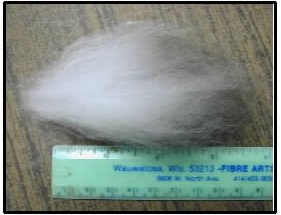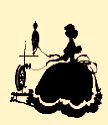Fuzzy Sweaters, Scarves and Hats
By Donna Towel l
We all know that the American Fuzzy lop is a great show rabbit, super cute and has a great
personality, but did you know they are a rabbit that can help us stay warm and cozy. How
many of you have ever considered making luscious yarns out of the fiber you are forever
combing out of your rabbits? Fuzzy Lops are in the wool rabbit family and produce almost
the same fiber as the Angora rabbits just a little shorter but they do not produce the quantity
of an angora. The wool fiber of a rabbit is seven times warmer than sheep’s wool and has
the elegance and softness of a fur coat. One of the characteristics of rabbit wool is that it will
produce a fur like halo to what ever article you choose to make. The halo appears because
the tips of the rabbit fiber are flat and this allows the ends to slip out of the yarn and create
the soft fuzzy halo texture. Rabbit fiber is one of those fibers that you usually blend with
others but it all depends on what your finished product is going to be. For example if you
want to make a garment such as a sweater , hat , mittens or items that need to hold their
shape you may want to blend your rabbit fiber with another fiber that has memory. What I
mean by memory is bounce. Sheep’s wool has a very nice crimp to its fiber that will give it
the elasticity to bounce back into shape. Even though rabbit fiber does have a crimp you
will find that it just does not have the spring or life it needs to bounce back and keep the
shape of the garment after being worn. So to knit a 100% rabbit fiber sweater be prepared
that after wearing it once your sleeves may stretch and loose their shape. Remember what I
said earlier about the wool being seven times warmer than sheep’s wool? Yep, you are going
to be very warm in your sweater with its sleeves down past the tips of your fingers swinging
past your knees. So, for garments that need to fit well I recommend blending with sheep
fiber. Other items such a scarves, blankets, shawls, and ponchos, 100% rabbit will give a
beautiful drape and elegant look and feel to your product where the stretch should not throw
off its appearance. When blending your rabbit fiber always keep in mind that you should use
other fibers that will compliment the rabbit fiber and not waste its softness. Blend with
other soft fiber; Marino, Rambouillet, Corriedale and Shetland Sheep, Silk, alpaca, llama,
kid angora goat, buffalo, qiviut (musk ox), rayon and nylon. Now not all of these other
fibers have strong memories so be careful with your combinations and garment choice.
Another quality you want to look for with blending is to use other fibers that are similar in
length. It will surely make your hand spinning easier and much smoother.
The fuzzy lop at least two time a year will produce a lovely skirt and full shoulders of fiber
that are just perfect for spinning. The best length of fiber for spinning is 2 1/2 inches or
longer.

This is where you can harvest the best wool for spinning
There are three ways that you can harvest the coat. The first way, and the one spinners,
prefer is to pluck out the loose fibers. By plucking the fibers you will get all one staple
length (fiber length) which will make the strongest and smoothest yarn when spun.
Unfortunately, this is usually not the way the rabbit would prefer so when you pluck be
gentle, make sure the rabbit is molting, take small amounts at a time and don’t tug on the
new growth coming in. The second way but graded for retail as second choice, is clipping
. The reason for the down grade is when you clip the fiber with a scissors you will also be
clipping the new coat growing in and all the fibers will not be the same length. Why this is
not preferred is that the short hairs could cause shedding and your yarn may not be as strong
. I do clip most of my angoras because I find that the coats grow in more even, they stay soft
and they will not produce more guard hairs like after plucking. With my angoras I grow their
coats out to at least a four inch staple length which will greatly reduce any shedding and still
keep the yarn strong. When I am harvesting my Fuzzy lop fiber I will always pluck the skirts
to get the longest fiber.

To Pluck hold the tips and gently pull

This is an ideal staple length, about 3 inch
The last way of harvesting the fiber is to use combings after grooming your rabbit with a
comb or slicker brush. These fibers can be used but may produce a yarn that has a lot of
nebs and noils. Those are knots, lumps and bumps. Now, is that bad? Not necessarily, as
then it is called novelty yarns that create a unique texture and feel to your finished article. It
can just be a little harder to spin.
Once you have harvested your rabbit’s fiber store it where it can breathe in a container with
holes or an open bag but be careful of moths. Moths LOVE rabbit wool. You need to
disguise the natural odor of the fiber by adding a different sent like cedar, lavender, Irish
spring soap, Camphor or mothballs( if you can put up with that smell). Also if you can store
the fiber in a place where it will freeze that will help keep the pesky moths away. Do not
store fiber compressed or tightly packed because it will felt from its own moisture and the
pressure.
All right, you have your garment planned out, fiber collected and now you need to get your
fibers ready to spin. I know some of us have been to fairs or shows where we have seen
people spinning the fiber right off the rabbit sitting on their laps. It surely can be done and i
t looks real cool when it is demonstrated but to get any real work done leave the lap rabbit
for the fun, show off spinning. Get yourself a set of hand carders, a drum carder or send
your fiber out to be processed. These tools will properly prepare your fiber by aligning the
fibers all in one direction so they will pull out evenly and smoothly while spinning. Once
carded, your fibers can be rolled into a rolag, roving or a batt. A rolag is made from the
combed fibers removed from hand carders. The small batt of fiber from the hand carders are
then rolled up into a sausage shape starting from tips to ends. Rolags will give you a woolen
yarn (soft and fluffy) because the fibers are fed into the spinning wheel from the center of
the strand allowing for more air to be spun into the yarn. A batt is formed after taking the
fiber off a drum carder. Holding the batt you can tear smaller strips of fiber from the batt to
spin or you can hand pull the batt into rovings. A roving is a long continues rope of fiber
from which you can spin for a long time with out having to stop. Batts and rovings will
produce a soft but stronger yarn because the fibers are spun from tip to end. This will
produce a worsted yarn that will be very smooth and strong.

Some tools of the trade
Samples of a Batt and how it can be torn
for spinning, a roving and a rolag.

Preparation of your fiber is the most important part of producing a beautiful yarn. Your
fiber has to be cleaned and what I mean by cleaned is picked free of vegetation debris. You
do not have to wash rabbit fiber before you get ready to spin. Rabbits keep themselves
fairly clean and there isn’t a large amount of natural oil in their coats that needs to be
removed like in sheep fiber. Spinning is now your next step and you can use a drop spindle
or a spinning wheel. When you use an exotic fiber such as rabbit there are a few things you
need to remember when spinning. First, the wheel that you use should be one where you can
adjust the flywheel to a faster speed with different size whorls. Not all wheels have that
ability. The fly wheel needs to spin faster to create a tighter twist which will securely hold
the fine and slippery fibers. The most important tip I feel is to have a light hand and a
relaxed grip on the fibers you are holding while spinning. Rabbit yarn is usually spun fine
and can be plied, (that is spinning two or more threads together) to create a thicker yarn if
desired. Spinning on the wheel is a skill of rhythm. To get the feel of what it is like to spin
have a seat, pat your head, rub your tummy and tap your foot all at the same time in a slow
smooth motion. You got it , now sit at the wheel and keep your hands relaxed and your eyes
focused on the draft zone. The draft zone is the triangle of fibers right before they are
ready to spin. Never let the fibers twist in the draft zone until you are ready.

Here are the parts of the spinning wheel.
Find a spinning wheel with adjustable whorls.
They work best for spinning exotic fibers such as rabbit.

The area between Morgan's thumbs is the draft zone.
Don't allow the fibers to twist in this area until you are ready. Your eyes should be looking at the draft
zone while spinning
After you finish spinning and maybe plying your yarn it is then ready to be removed from
the bobbin using a knitty- kotty or a yarn swift. These will wind your finished yarn into a
skein. Once in a finished skein this is when the yarn can be washed using a mild soap and
warm water. Do not agitate when washing or it may felt. This will also set the spin and
release any extra energy (over twisting) that may have been over spun into your yarn. Hang
your skein to dry with a light weight on the end.
One must remember spinning is fun and relaxing when you feel the rhythm. There is
nothing more rewarding than being able to admire a produce that you produced from
beginning to end. Raise the fuzzy lops, show them and now allow them to keep you warm.
Stop throwing out that useful fiber and get to work.

Ahhhh! the finished product.
You just can't beat the softness and elegance of rabbit

ALL RIGHTS RESERVED. NO PARTS OF THIS ARTICLE MAY BE COPIED WITHOUT PERMISSION FROM AUTHOR
copyrights reserved![]()